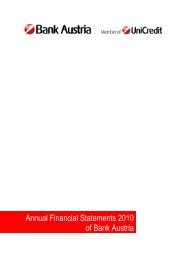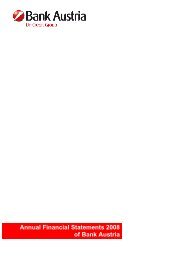Annual Financial Statements 2011 of Bank Austria
Annual Financial Statements 2011 of Bank Austria
Annual Financial Statements 2011 of Bank Austria
You also want an ePaper? Increase the reach of your titles
YUMPU automatically turns print PDFs into web optimized ePapers that Google loves.
Management Report <strong>of</strong> UniCredit <strong>Bank</strong> <strong>Austria</strong> AG<br />
From the middle <strong>of</strong> January 2012, the exaggerated reactions seen<br />
in financial markets reversed, leading to more normal levels: from<br />
the end <strong>of</strong> <strong>2011</strong> to the middle <strong>of</strong> February 2012, the Hungarian<br />
forint appreciated significantly (+8.1% against the euro / +7.5%<br />
against the Swiss franc), CDS spreads and bond spreads<br />
narrowed (to 493 basis points and 6.73 percentage points,<br />
respectively, on 10-year bonds). The stock market also recovered<br />
lost ground. When the government accepted a number <strong>of</strong><br />
regulatory demands by the EU, the fundamentals-based<br />
assessment <strong>of</strong> the highly integrated Hungarian economy got the<br />
upper hand again.<br />
Hungary has an open economy, external trade (exports + imports)<br />
totals 165% <strong>of</strong> GDP, the large stock <strong>of</strong> direct investment is a<br />
distinct feature <strong>of</strong> the country’s competitive industries, 65% <strong>of</strong> retail<br />
loans and 47% <strong>of</strong> business loans are denominated in foreign<br />
currency and banks with international owners account for 88% <strong>of</strong><br />
the banking sector’s total assets. All this makes it unlikely that the<br />
country will go it alone. Hungary’s basic balance is highly positive<br />
(8.8% <strong>of</strong> GDP), and its currency reserves <strong>of</strong> € 37 bn are higher<br />
than the short-term foreign debt <strong>of</strong> the entire business sector (€ 25<br />
bn). Overall, although there have been occasional fears <strong>of</strong> a<br />
default, we think that this is unlikely. In our base scenario we<br />
assume that Hungary will reach an agreement with the EU and the<br />
IMF in March/April 2012 and that the situation will continue to ease<br />
as the year progresses.<br />
The Hungarian banking subsidiary <strong>of</strong> UniCredit <strong>Bank</strong> <strong>Austria</strong> AG<br />
performed strongly in the difficult environment which prevailed in<br />
<strong>2011</strong>. Although the provisioning charge rose slightly, and despite<br />
the bank levy, it generated the largest pr<strong>of</strong>it among the four<br />
Central European countries and achieved the highest return on<br />
equity. The NPL ratio is below the average for all our banks in<br />
CEE. The Hungarian banking subsidiary is the seventh-largest<br />
bank in the country, with a market share <strong>of</strong> about 5%. Its business<br />
focuses on the less exposed corporate customer segment. In our<br />
multi-year plan Hungary, an EU member country where integration<br />
has reached an advanced stage, is not among the growth markets.<br />
The strategy <strong>of</strong> expansion has been suspended, not least on<br />
account <strong>of</strong> political uncertainty, but this decision may be revised in<br />
2013.<br />
Movements in CEE currencies in <strong>2011</strong> were volatile. Especially<br />
the shift from long-term capital inflows to short-term portfolio<br />
investments increased sensitivity to changes in sentiment among<br />
international investors. Weighted by contributions to operating<br />
income <strong>of</strong> CEE operations, CEE currencies (in <strong>Bank</strong> <strong>Austria</strong>’s<br />
perimeter, without Poland) depreciated by about 5.5% in the<br />
reporting period (based on a comparison <strong>of</strong> year-end data)<br />
against both the euro and the US dollar. It should be noted in this<br />
context that this average figure includes two euro area countries<br />
and three countries with de facto fixed exchange rates against the<br />
euro. Overall developments were strongly influenced by the<br />
Turkish lira, which has a strong weight in the calculation and<br />
showed autonomous depreciation <strong>of</strong> 15.3% against the euro and<br />
18.0% against the US dollar (year-end <strong>2011</strong> compared with yearend<br />
2010). The Hungarian forint depreciated at double-digit rates<br />
against the euro and the US dollar (as the situation in the country<br />
came to a head in the autumn <strong>of</strong> <strong>2011</strong>).<br />
Development <strong>of</strong> total assets<br />
Overview: UniCredit <strong>Bank</strong> <strong>Austria</strong> AG’s balance sheet showed<br />
moderate and balanced trends in <strong>2011</strong>, despite the volatile<br />
environment and pronounced uncertainty among business partners<br />
and customers. As at 31 December <strong>2011</strong>, total assets were<br />
€ 125.0 bn, up by € 4.3 bn or 3.5% from the level as at<br />
31 December 2010. As in 2010, the new focal areas <strong>of</strong> business<br />
policy, by which the bank responded to changes in the overall<br />
environment following the financial market crisis, were favourably<br />
reflected in movements in balance sheet items (and even more<br />
strongly in income statement items). Customer business being the<br />
top priority, the bank’s proprietary trading activities were reduced<br />
already in 2010 and the capital base was significantly<br />
strengthened. Overall, the assets side <strong>of</strong> the bank’s balance sheet<br />
reflected weak credit demand in the <strong>2011</strong> financial year. Loans and<br />
advances to customers rose by 2.1%. Significant increases were<br />
seen in medium-term and long-term loans, including mortgage<br />
loans (+6.1%) and local-authority loans (+5.0%), while loans to<br />
private individuals and low-volume loans as well as export loans<br />
declined slightly.<br />
As the cost <strong>of</strong> funding via wholesale markets rose strongly, the<br />
bank made efforts in <strong>2011</strong> to strengthen the funding side on a<br />
sustainable basis. Overall, primary funds rose by € 2.9 bn or 13%<br />
as the bank significantly increased the volume <strong>of</strong> its own issues<br />
(debts evidenced by certificates) while customer deposits were<br />
stable; this was the main change on the liabilities side. Especially<br />
mortgage bonds, which are covered bonds, met investors’ stronger<br />
preference for security. Loans and advances to customers (which<br />
amounted to € 68.1 bn, accounting for about 54.5% <strong>of</strong> total assets)<br />
were thus funded with primary funds (€ 70.3 bn or 56% <strong>of</strong> the<br />
balance sheet total) to the extent <strong>of</strong> 103.1% (year-end 2010:<br />
100.4%). Shareholders’ equity (the sum total <strong>of</strong> items 9 to 12 on<br />
the liabilities side) remained at the high level <strong>of</strong> € 14.0 bn reached<br />
after the capital increase at the beginning <strong>of</strong> 2010; it accounted for<br />
a high 11.2% <strong>of</strong> the balance sheet total. Other significant changes<br />
in balance sheet items – a strong increase in bonds and other<br />
fixed-income securities (within which government bonds were<br />
reduced) on the assets side, and an increase in amounts owed to<br />
credit institutions on the liabilities side – are related to internal<br />
financing tasks performed by UniCredit <strong>Bank</strong> <strong>Austria</strong> within<br />
UniCredit Group, not least in its capacity as sub-holding company<br />
for CEE operations.<br />
Major balance sheet items – comparison <strong>of</strong> year-end levels<br />
<strong>2011</strong>/2010<br />
31 Dec. <strong>2011</strong> 31 Dec. 2010<br />
Assets<br />
Loans and advances to credit institutions (item 3)<br />
18.3% 19.1%<br />
Loans and advances to customers (item 4) 54.5% 55.2%<br />
Securities including shares (items 5 and 6) 9.7% 7.8%<br />
Shares in group companies (item 8) 9.9% 10.4%<br />
Liabilities and Equity<br />
Amounts owed to credit institutions (item 1) 25.5% 25.0%<br />
Amounts owed to customers (item 2) 37.0% 38.0%<br />
Debts evidenced by certificates (item 3) 19.2% 17.4%<br />
Primary funds (items 2 and 3) 56.2% 55.5%<br />
Capital and reserves (total <strong>of</strong> items 9, 10, 11 and<br />
12)<br />
11.2% 12.0%<br />
<strong>Bank</strong> <strong>Austria</strong> – <strong>Annual</strong> <strong>Financial</strong> <strong>Statements</strong> <strong>2011</strong> 188
















